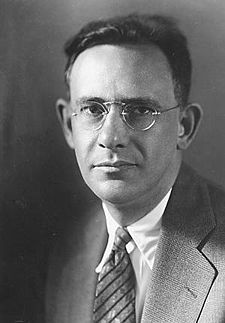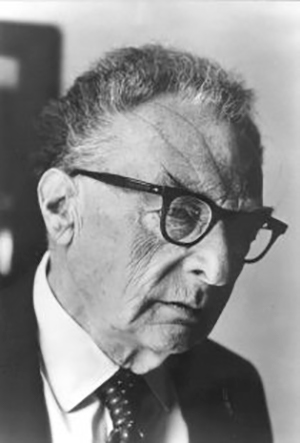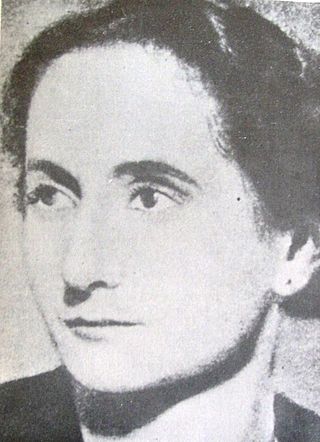
Edward Sapir was an American anthropologist-linguist, who is widely considered to be one of the most important figures in the development of the discipline of linguistics in the United States.
The following outline is provided as an overview and topical guide to linguistics:

Roman Osipovich Jakobson was a Russian linguist and literary theorist.
Dell Hathaway Hymes was a linguist, sociolinguist, anthropologist, and folklorist who established disciplinary foundations for the comparative, ethnographic study of language use. His research focused upon the languages of the Pacific Northwest. He was one of the first to call the fourth subfield of anthropology "linguistic anthropology" instead of "anthropological linguistics". The terminological shift draws attention to the field's grounding in anthropology rather than in what, by that time, had already become an autonomous discipline (linguistics). In 1972 Hymes founded the journal Language in Society and served as its editor for 22 years.
In linguistics, transformational grammar (TG) or transformational-generative grammar (TGG) is part of the theory of generative grammar, especially of natural languages. It considers grammar to be a system of rules that generate exactly those combinations of words that form grammatical sentences in a given language and involves the use of defined operations to produce new sentences from existing ones.
The Prague school or Prague linguistic circle is a language and literature society. It started in 1926 as a group of linguists, philologists and literary critics in Prague. Its proponents developed methods of structuralist literary analysis and a theory of the standard language and of language cultivation from 1928 to 1939. The linguistic circle was founded in the Café Derby in Prague, which is also where meetings took place during its first years.

A speech community is a group of people who share a set of linguistic norms and expectations regarding the use of language. It is a concept mostly associated with sociolinguistics and anthropological linguistics.

Morris Halle, né Pinkowitz, was a Latvian-born American linguist who was an Institute Professor, and later professor emeritus, of linguistics at the Massachusetts Institute of Technology. The father of "modern phonology", he was best known for his pioneering work in generative phonology, having written "On Accent and Juncture in English" in 1956 with Noam Chomsky and Fred Lukoff and The Sound Pattern of English in 1968 with Chomsky. He also co-authored the earliest theory of generative metrics.

Syntactic Structures is an important work in linguistics by American linguist Noam Chomsky, originally published in 1957. A short monograph of about a hundred pages, it is recognized as one of the most significant and influential linguistic studies of the 20th century. It contains the now-famous sentence "Colorless green ideas sleep furiously", which Chomsky offered as an example of a grammatically correct sentence that has no discernible meaning, thus arguing for the independence of syntax from semantics.
In linguistics and social sciences, markedness is the state of standing out as nontypical or divergent as opposed to regular or common. In a marked–unmarked relation, one term of an opposition is the broader, dominant one. The dominant default or minimum-effort form is known as unmarked; the other, secondary one is marked. In other words, markedness involves the characterization of a "normal" linguistic unit against one or more of its possible "irregular" forms.
Robert B. Lees was an American linguist.
The axiom of categoricity is a term coined by J. K. Chambers in 1995 to refer to the once-widespread tenet of linguistic theory that in order to properly study language, linguistic data should be removed or abstracted from all real-world context so as to be free of any inconsistencies or variability. This principle was, for different theorists and schools of thought, taken as a prerequisite for linguistic theory, or as a self-evident falsehood to be rejected. It remains an influential idea in linguistics.
The history of linguistics in the United States began to discover a greater understanding of humans and language. By trying to find a greater ‘parent language’ through similarities in different languages, a number of connections were discovered. Many contributors and new ideas helped shape the study of linguistics in the United States into what we know it as today. In the 1920s, linguistics focused on grammatical analysis and grammatical structure, especially of languages indigenous to North America, such as Chippewa, Apache, and more. In addition to scholars who have paved the way for linguistics in the United States, the Linguistic Society of America is a group that has contributed to the research of linguistics in America. The United States has long been known for its diverse collection of linguistic features and dialects that are spread across the country. In recent years, the study of linguistics in the United States has broadened to include nonstandard varieties of English speaking, such as Chicano English and African American English, as well as the question if language perpetuates inequalities.
Yakov Malkiel was a U.S. (Russian-born) Romance etymologist and philologist. His specialty was the development of Latin words, roots, prefixes, and suffixes in modern Romance languages, particularly Spanish. He was the founder of the journal Romance Philology.
Interactional sociolinguistics is a subdiscipline of linguistics that uses discourse analysis to study how language users create meaning via social interaction. It is one of the ways in which linguists look at the intersections of human language and human society; other subfields that take this perspective are language planning, minority language studies, quantitative sociolinguistics, and sociohistorical linguistics, among others. Interactional sociolinguistics is a theoretical and methodological framework within the discipline of linguistic anthropology, which combines the methodology of linguistics with the cultural consideration of anthropology in order to understand how the use of language informs social and cultural interaction. Interactional sociolinguistics was founded by linguistic anthropologist John J. Gumperz. Topics that might benefit from an Interactional sociolinguistic analysis include: cross-cultural miscommunication, politeness, and framing.

María Rosa Lida de Malkiel, born Maria Rosa Lida, was an Argentine philologist. Notable as an Hispanist medievalist, she came to the United States on a Rockefeller Foundation program of study. Beginning in 1947, Lida de Malkiel lectured for many years in the US, including at Harvard University, the University of California at Berkeley, and Stanford. An advisor to the editorial boards of two professional journals, in the 1950s she was admitted to the Real Academia Española and the Academia Argentina de Letras.

Digital infinity is a technical term in theoretical linguistics. Alternative formulations are "discrete infinity" and "the infinite use of finite means". The idea is that all human languages follow a simple logical principle, according to which a limited set of digits—irreducible atomic sound elements—are combined to produce an infinite range of potentially meaningful expressions.
Deborah Sue Schiffrin was an American linguist who researched areas of discourse analysis and sociolinguistics, producing seminal work on the topic of English discourse markers.






